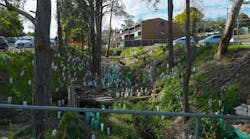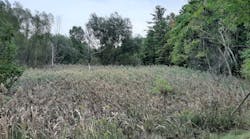Confessions of a Contractor
By Sandy Wiggins
Hanging in a cheap frame on the wall in an unused bedroom of my home is an 8×10 photograph of a large construction site. In the foreground, a trim young man strikes a pose, eyes full of authority and the joy of command. Behind him acres of red dirt covered with the crisp footprints of heavy equipment undulate to the horizon. Giant yellow pans, bulldozers, and excavators rumble over the landscape, changing it according to some hidden plan. In a distant corner, a mountain of stumps bears witness to their technological muscle.
I cringe now when I see myself in that photo from 20-odd years ago because it forces me to think about the countless times I’ve pushed nature out of the way in the interest of progress. But I keep the photo around to remind me that often-when we think we are doing our professional best-we are blinded by our belief in practices that fail to understand their own downstream consequences. Much of my time these days is spent educating myself and others about those downstream consequences and what we can do to change them. The company I work for, W.S. Cumby & Son Inc., is a regional construction management firm based in Springfield Township in Delaware County, PA, just a few miles southwest of Philadelphia. Over the last few years, we have learned a lot about those consequences and as a result have begun the slow and sometimes painful process of changing the way we do business.Our first exposure to sustainable design and construction, or “green building,” was through a young architect named Scott Dylan Kelly who refused to settle for anything less. We muddled our way through his project, complaining behind his back and frustrated by his insistence that we use materials and procedures that differed from our tried-and-true best practices. We knew he just didn’t understand how to build a building.A short while later, we were asked by another potential client to discuss green building. We had, of course, told the client that we’d built a green building-albeit leaving out the part about not doing it willingly. To prepare ourselves for the discussion, we figured it might be a good idea to get some education on the subject. During this initial education, it occurred to me perhaps there really was something to the idea that the building industry was a major culprit in the wanton depletion and degradation of the world’s natural resources and systems. Maybe-in spite of our best intentions-we were doing it all wrong. Then I stumbled on a quote from the well-known green architect William McDonough: “Ignorance ends today, negligence begins tomorrow.” Education can be a real party pooper.It turned out that our next truly green project was our own new corporate office building. We had already progressed through schematic design with our consultants when we started getting a little uncomfortable from all the education we were giving ourselves. So we decided to change course and develop the building using the US Green Building Council’s Leadership in Energy and Environmental Design (LEED) rating system. As anyone accomplished in sustainable design will tell you, this is not a good idea. You make 90% of your mistakes on the first day, and we’d passed that day months before. The emotional and fiscal costs of backtracking turned out to be considerable, but we persisted, determined to make the best of the project and learn from it what we could. We also hired that young architect, Scott Dylan Kelly, to help us fix those mistakes.Our new offices sit on a beautiful and heavily wooded site covered with steep slopes. Stormwater management and site disturbance quickly surfaced as two major areas of concern once we committed to LEED. Our use variance required that we build 60 parking spaces, and the township planning ordinance stipulated that we could not increase the rate of stormwater flow from the site. The standard practice of clearing a half acre of mature trees to build a basin no longer seemed like a great option to us. We searched for help and located a fellow named Tom Cahill of Cahill and Associates in West Chester, PA, who purportedly knew something about alternative stormwater management. So we paid him a visit to see if he would join our team.The first time we met Cahill, he gave us a lecture reminiscent of my eighth-grade science teacher about the hydrologic cycle. I’d forgotten all about it. Then he connected the dots for us so we could see the consequences of the industry’s best management practices. We hired him on the spot. Cahill and his office designed a couple of parking lots for us using porous pavement and infiltration beds that are capable of handling a 100-year storm event and deal with the problem of volume rather than rate of flow from our site-a very important distinction. The lots also trap and filter the suspended solids and other nonpoint-source pollutants carried in the stormwater. The first time we submitted the plans to the township engineer, he rolled them up and sent them back to us. So we invited Cahill to come with us to give him an education as well. It worked. Now the township is bragging about our site.Since we started educating ourselves on sustainability and green building, we’ve never stopped. We run an in-house curriculum for our staff with the initial objective of having every person in our company who touches a project become a LEED Accredited Professional. It’s only the first baby step, and we’re about halfway there. Other people in the industry heard we knew something about green building and invited us to talk to them. We’ve gone on to deliver seminars and lectures to more than 800 design and construction professionals from other firms in our region. Education is the key to solving the sustainability equation.We also learned that change is hard but gets easier with time. Our first green building – or rather, the first one we wanted to build-was difficult, and the learning curve was steep. We had to push ourselves to learn new methods, materials, and systems; deal with different sequencing issues; develop new quality-control procedures; figure out construction waste management and commissioning; and struggle through the LEED certification submittal. But we’ve been fortunate to go on to other green projects, and with each one, we learn a bit more and become more effective and efficient. We’re making money, and we’re making a difference.
On a recent rainy Saturday morning, my 13-year-old son and I stopped by the new offices so I could pick up some paperwork. His class is studying the hydrologic cycle, a subject for which he is well prepared. He’s become an avid student of sustainability under my tutelage and is quick to remind me when I lapse into my old, conditioned behaviors. He is acutely aware that his generation will be the one to clean up our mess. As we pulled into the parking lot, the sky opened up, and we sat in the car together to watch the sheets of water disappear through the pavement.
Sandy Wiggins is vice president of W.S. Cumby & Son Inc. in Springfield, PA, and chair of the Delaware Valley Green Building Council.

